Innovations in Packaging Technology
Innovations in packaging technology are playing a crucial role in the Ultra-high Temperature (UHT) Milk Market. Advanced packaging solutions not only enhance the shelf life of UHT milk but also improve its safety and convenience for consumers. For instance, the introduction of aseptic packaging has allowed UHT milk to be stored without refrigeration, thereby reducing transportation costs and energy consumption. This technological advancement is expected to drive market growth, as it appeals to environmentally conscious consumers. Furthermore, the market is projected to witness a compound annual growth rate of around 7% over the next few years, largely attributed to these packaging innovations that enhance product appeal and accessibility.
Rising Demand for Dairy Alternatives
The Ultra-high Temperature (UHT) Milk Market is also influenced by the rising demand for dairy alternatives. As more consumers adopt plant-based diets or seek lactose-free options, the market for UHT milk is adapting to these changing preferences. While traditional UHT milk remains popular, there is a noticeable increase in the availability of UHT processed dairy alternatives, such as almond and soy milk. This diversification within the UHT segment is likely to attract a broader consumer base, potentially leading to a market growth rate of around 6% in the coming years. The ability to cater to diverse dietary needs positions the UHT milk market favorably in a competitive landscape.
Increasing Health Consciousness Among Consumers
The Ultra-high Temperature (UHT) Milk Market is benefiting from a growing trend of health consciousness among consumers. As individuals become more aware of nutritional information and dietary choices, there is a rising demand for milk products that offer health benefits. UHT milk, often fortified with vitamins and minerals, is perceived as a healthier alternative to traditional milk. Market data indicates that the demand for fortified UHT milk has surged, with a significant portion of consumers actively seeking products that contribute to their overall well-being. This shift in consumer behavior is likely to propel the UHT milk market forward, as manufacturers respond by developing innovative, health-oriented products.
Expansion of E-commerce and Online Retail Channels
The Ultra-high Temperature (UHT) Milk Market is witnessing a transformation due to the expansion of e-commerce and online retail channels. As consumers increasingly turn to online shopping for their grocery needs, the accessibility of UHT milk products has improved significantly. This trend is particularly evident in urban areas, where busy lifestyles drive the demand for convenient shopping solutions. Recent statistics suggest that online sales of UHT milk have increased by over 15% in the past year, indicating a shift in purchasing behavior. As e-commerce continues to grow, it is expected that the UHT milk market will benefit from enhanced distribution networks and greater consumer reach.
Rising Consumer Preference for Long Shelf Life Products
The Ultra-high Temperature (UHT) Milk Market is experiencing a notable shift in consumer preferences towards products with extended shelf life. This trend is driven by the increasing demand for convenience and the desire to minimize food waste. UHT milk, which can be stored for several months without refrigeration, aligns perfectly with these consumer needs. According to recent data, the UHT milk segment has seen a growth rate of approximately 8% annually, reflecting a robust market response to this demand. As consumers become more aware of the benefits of long-lasting dairy products, the UHT milk market is likely to expand further, catering to both urban and rural populations who seek practical solutions for their dairy consumption.


















Leave a Comment